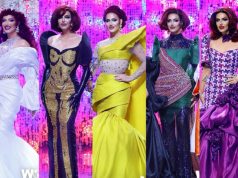
Canadian drag queen Kyne released a video that offered an overview of the history of the traditional “terno” dress.
Filipino drag queens previously designed their first runway looks for “Drag Race Philipines” based on their interpretations of Filipiniana clothing.
RELATED: ‘Sa mga kababayan’: Rupaul’s Ongina, Rock M. Sakura to critique ‘Drag Race PH’ looks
Kyne, whose real name is Kyne Santos, is a former contestant of “RuPaul’s Drag Race” in Canada.
In the video, she was wearing a red, glittery terno dress while explaining its history to audiences who might not be familiar with it.
“What is a terno? A little history of the Filipiniana dress!” Kyne tweeted.
What is a terno? A little history the Filipiniana dress! pic.twitter.com/Qm3NF6LJvs
— Kyne (@onlinekyne) August 23, 2022
Kyne was later praised for the informative video. Her tweet garnered 1,350 retweets, 283 quote-retweets and 6,842 likes.
She explained that the terno dress was originally a baro’t saya, a clothing style that Filipino women wore during the Spanish colonization.
“(Terno dress) was also known as the Maria Clara dress, named after the mestiza protagonist from a novel by the very influential Jose Rizal,” said the 24-year-old drag performer
She then noted how Imelda Marcos, the wife of late President Ferdinand Marcos Sr., popularized the terno version known today.
Kyne also gave two sides of the coin about the Marcos matriarch and her family.
“She was called the Jackie Kennedy of Asia but she was really more Marie Antoinette,” the young artist explained.
In reference to the infamous queen of France, Kyne went on to briefly tell about the Marcos dictatorship and the historical record of $10 billion worth of siphoned state funds.
RELATED: Marcos hidden wealth may show up for 2022, says US litigator
Kyne also mentioned that their son Ferdinand Marcos Jr. was elected to the highest position in the land.
While some people associate dictatorship with the “terno” style, Kyne said that it connects her to her home country instead.
“Filipinos are taking it back from Imelda and wearing it as a badge of national pride. I can’t think of another garment that more strongly represents our history,” she said.
Other parts of terno’s history
Gino Gonzales, a scenographer, and Mark Lewis Higgins, a costume designer, have also mentioned in their book that this style was derived from the baro’t saya and other traditional outfits that Filipino women have worn from 1860 to 1960.
Their book titled “Fashionable Filipinas: An Evolution of the Philippine National Dress in Photographs, 1860-1960” was published in 2015.
In the 1920s, the term “terno” also has a different meaning.
Instead of the common one-piece dress, a “terno” outfit at that time means a matching set of clothes.
“Terno was a reference word that they used if they wanted it to match—the design, burda, etc. were all matching. It didn’t refer to a single dress until about the 1940s,” Higgins was quoted in an article as saying.
The currently known version of it with the signature butterfly sleeves was attributed to Ramon Valera, National Artist for Fashion Design.
Imelda is also known for wearing the terno with butterfly sleeves.
In his profile, the National Commission for Culture and the Arts described Valera as a “visual icon to the world via the terno.”
“To the world, the butterfly sleeves became the terno’s defining feature. Even today, Filipino fashion designers study Valera’s ternos: its construction, beadworks, applique, etc.,” the NCCA’s profile reads.









